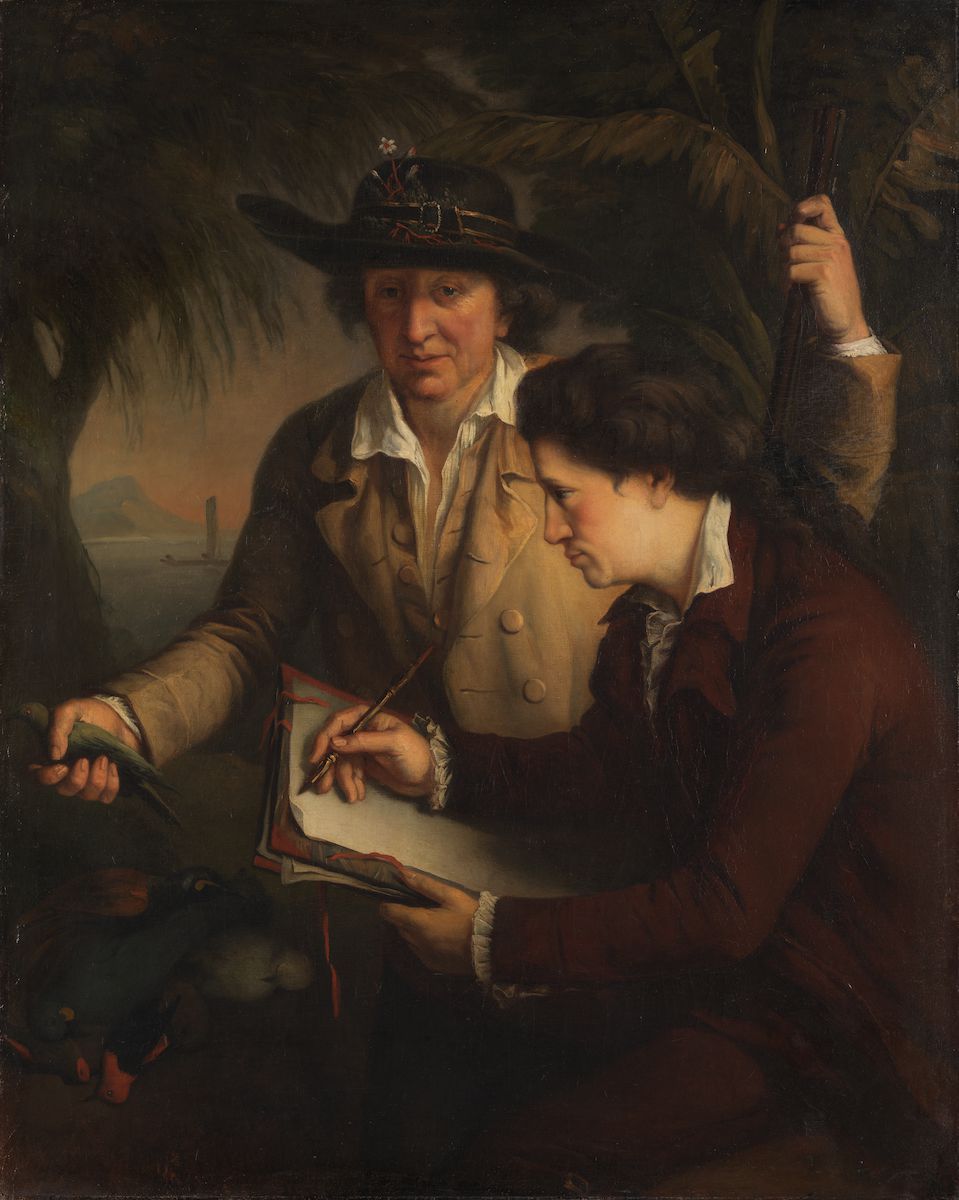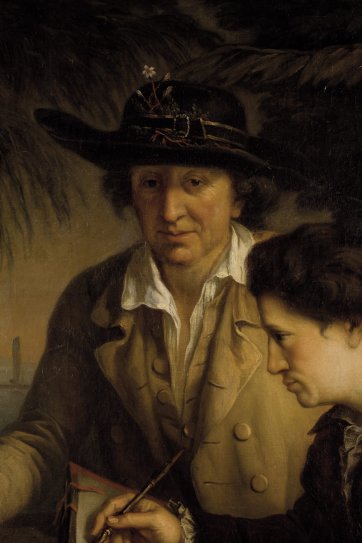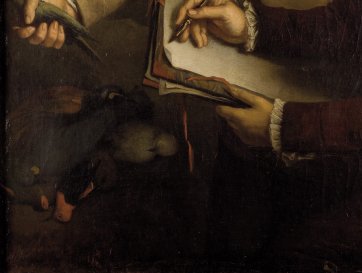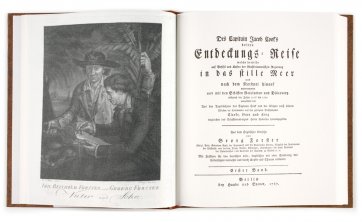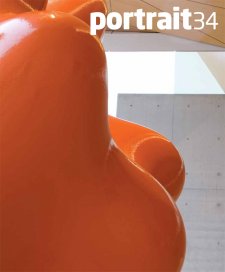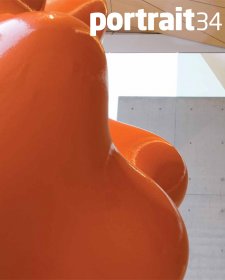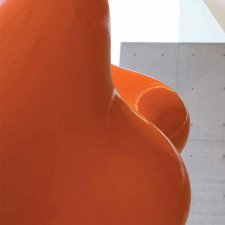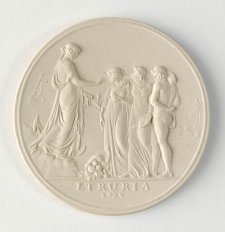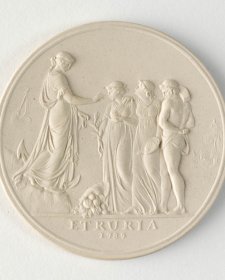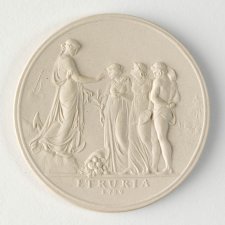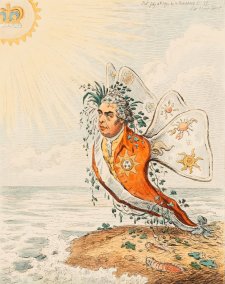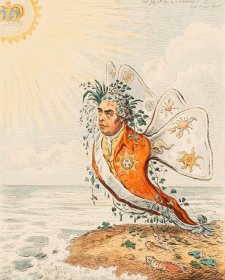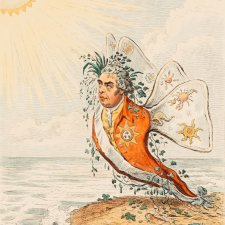When Joseph Banks, Daniel Solander and James Lind pulled out of James Cook’s second great voyage of exploration in May 1772, the two men depicted in the National Portrait Gallery’s latest major acquisition seized the opportunity of a lifetime.
Johann Reinhold Forster (1729–1798), born near Danzig and educated in Germany, had worked in Russia before moving to London in 1766 to teach, translate and write. On the strength of his Introduction to Mineralogy (1768), Catalogue of British Insects (1770) and other productions, he was elected a Fellow of the Royal Society in 1772. His son Johann Georg, or George (1754–1794), born in Nassenhüben, Polish Prussia, was so gifted in languages that he had worked as a translator from the age of twelve. Between them the two men possessed the skills of naturalist, philosopher, translator, writer and artist. Keen to join the Resolution, they were endorsed by prominent men, and within six weeks of ‘Old’ Forster’s first putting himself forward, with a loose contract hastily negotiated, they set sail.
Cook embarked on his second voyage – which bypassed Australia – charged with testing the chronometer as a means of establishing longitude, and with finding or disproving the existence of the fabled ‘great southern continent’ (to wit, confirming or putting paid to the notion of a significant, untapped source of trade). It was a meandering, looping journey, in the course of which the Resolution spent many months on the empty sea, including torturous periods in the Antarctic. Cook himself wrote on his second voyage that ‘ambition leads me not only farther than any man has been before me, but as far as I think it possible for man to go’. By default, any man who found himself on the Resolution, regardless of fitness or temperament, was dragged with him all the way to the base of the globe – where, to the Forsters, ‘the whole scene looked like the wrecks of a shattered world’.
Johann Forster was a querulous man (his biography, by Michael Hoare, is titled The Tactless Philosopher), and his journal vividly evokes the adversities of the expedition as well as its wonders. Certainly his claim to have had the worst cabin on the Resolution seems plausible enough. At the end of 1773, after nineteen months aboard, he describes how he sought relief from his dank apartment, padding up to the executive end of the ship only to find that Cook had already given the space over to others: ‘My Cabin is cold and open to the piercing winds, full of unwholesome effluvia and vapours, every thing I touch is moist and mouldy and looks more like a subterraneous mansion for the dead than a habitation for the living. In the Captain’s Cabin there are broken panes, the apartment full of currents and smoke, a parcel of damp sails spread, and a couple of sailmakers at work... so that it cannot be reckoned one of the most comfortable places neither.’
Forster’s cubicle was perpetually awash underfoot; when sailors scrubbed the deck above, the swill sluiced through a seam above his bed. It was so dark that even in the daytime he had to work by candlelight; lumber was stored outside the door, so that he was often trapped inside, or stuck outside; sometimes sick animals were penned in there, on a kind of platform level with his bunk. In mid-January 1774, just above the Antarctic Circle, he spent an especially bad night: ‘I did not sleep all night, my Cabin was now below full of water, and I could not stir without being in water to my ankles; fell any thing down, it was most certainly soaked in the briny deluge. This disaster befel my pillow … The ocean and the winds raged all night. The morning came, I dragged my crippled limbs out of my bed and ate some breakfast.’
Soaked for years, recurrently scorbutic, it is little wonder that through much of the journey Old Forster was depressed: ‘I do not live, not even vegetate, I wither, I dwindle away’, he scribbled in the gloom. James Cook’s great twentieth-century biographer, John Beaglehole, encouraged his readers to ‘concede that for ocean voyaging no man was ever by physical or mental constitution less fitted than jr Forster’. In describing him as ‘dogmatic, humourless, suspicious, pretentious, contentious, censorious, demanding’– ‘an incubus’, no less – Beaglehole seems to be taking his cue from the astronomer on the second voyage, William Wales, who summed Johann Forster up as ‘unsociable, ill-tempered, lying, bribing, knavish, artful, deceitful, abusive’ and a ‘piratical pretender of knowledge’. Between them, Wales and Beaglehole seem to have shaken all the disparaging adjectives out of the thesaurus. James Cook himself is no more forthcoming on the personality of Forster than he is on that of any other man; he barely mentions him.
Nonetheless, it is likely that the two were often at loggerheads. So secret did Cook keep his intentions that a year and a half into the voyage, crewmembers including the midshipman, John Elliott, had no idea whether they were bound for home, or about to head deeper into the ice. On top of such perturbations, and his daily physical discomforts, like Banks before him Forster had to accept that gathering specimens was not the purpose of the expedition, and he had simply to rake them together opportunistically. In doing so, he was conscious of stumbling in the footsteps of Banks and Solander (‘how much they were assisted by the opulence of one, and the great skill in natural history of the other … ’), and he doubted that he would find anything that that shining pair had not already documented. In fact, he did a far better job than he believed: fabulous artefacts and specimens the Forsters gathered now form the backbones of several major museum collections, including those of the University of Göttingen and the Pitt Rivers Museum at Oxford.
After three years at sea, the Resolution expedition returned to England to a public eager for stories. Forster had understood that he would have the rights to the history of the voyage, which was sure to be a bestseller, but Cook was keen to tackle it himself. The Admiralty forbade Forster to publish his journal (it was first published two hundred years later, in 1976), and demanded intolerable editorial changes to his draft narrative. Consulting Johann’s notes, however, George Forster – under no ban – wrote A Voyage Round the World in His Britannic Majesty’s Sloop Resolution, which appeared just before Cook’s only book, A Voyage Towards the South Pole and Round the World (1777). Cook’s volume, handsomely illustrated, was subsidised by the Admiralty. Offered at the same price as Forster’s, it far outsold the young German’s elegant narrative.
George Forster wrote bitterly to Lord Sandwich declaring that in apportioning taxpayers’ money to the production of Cook’s account, he had ‘inhumanely’ destroyed the Forsters’ livelihood. In 1778 Johann Forster published his Observations Made During a Voyage Around the World, its philosophical, ethnological and natural-historical perspectives on the voyage complementing Cook’s no-nonsense report. Forster’s Observations, ranging over New Zealand, Tahiti, Tonga, Vanuatu, Easter Island, Terra del Fuego and elsewhere, is now a key text in Pacific studies. Cook never saw his own published record of his second voyage; by the time it appeared, he was well into his last. Not long after the awful news of Cook’s death reached England from Russia, the Forsters returned to Germany, to be renowned, henceforth, as the European experts on the Pacific.
George Forster has been described as the most intellectually distinguished of any person with whom Cook had extended contact. Just eighteen when he sailed on the Resolution, a Royal Academician at twenty-three, by his mid-twenties he was one of the all-time great German essayists. Von Humboldt was a friend, Goethe and Schlegel were fans; but he was to die at forty, exiled and spurned, his life wrecked by his idealistic alignment with the Jacobins in Mainz, where he had been the university’s head librarian at the time of the French occupation.
George Forster’s place in Australian, as opposed to broader Pacific, history begins with his essay ‘Neuholland und die brittische Kolonie in Botany-Bay’ (1786), written in Vilnius and published six months before the departure of the First Fleet. ‘Neuholland’ was a report for German readers on the geography, Indigenous inhabitants and resources of the nascent colony, for which George predicted great things, including a key part to play in Asian affairs.
The following year saw the publication of his German translation of Cook’s second, fatal trip on the Resolution. By way of introduction, Forster wrote a substantial essay, Cook, der Entdecker (Cook, the Discoverer). Herein, Forster adjudged that he had ‘obtained justice’ for Cook, whose merits had been ‘until now incompletely recognised.’ Cook, the Discoverer remains the only substantial account of the great navigator by someone who knew him well. Joseph Banks, for example, published nothing at all except a pamphlet on the Merino sheep.
Yet even if Banks, President of the Royal Society, had attempted a biographical sketch of Cook it could scarcely have been other than a marketing exercise for the British Empire. As a German, Forster was under no obligation to present Cook in a good light. Further, the nasty matter of the rival publications in 1777 had made it impossible for him or his father to stay in England. Both these factors make his generous account of Cook’s character and personality all the more remarkable: ‘Nature bestowed gifts in full measure on our discoverer, born in the modest cottage of a crofter.
The fundamental strength of his personality was his successful striving for action and for performing deeds. This urge was never at rest, it needed no stimulation by the senses, and enjoyment of sensuality meant nothing to him ... His curiosity could only be satisfied by knowledge ... He had an imagination which quickly grasped a situation, the ability to judge correctly and make unerring decisions. He possessed sensitivity of feeling, whose excess sometimes brought about passionate fits of temper, but still more frequently, it was ruled by reason, turned towards justice, kindness and humaneness.’
Not only does Cook, the Discoverer essay a systematic list of precisely what it was that Cook added to the store of human knowledge; it sets Cook in the philosophical and scientific context of his age. Its key idea is that ‘only our present century could satisfy Cook’s burning ambition by putting resources at his disposal, thus enabling him to become a discoverer, and Cook alone could come up to the expectations of his times’. Though perversely ignored by previous authorities on Cook, and indeed, only recently published in English with a fine essay by Nigel Erskine, George Forster’s Cook, the Discoverer is rapidly coming to be recognised as the starting point for the vast academic and popular enterprise that Cook scholarship has since become.
The Forsters’ portrait was painted by a French/Italian artist, Jean Rigaud, who trained in Italy and became a member of the Bologna Academy in 1766. Relocating to England in 1772, he was made a Royal Academician in 1784. During this period, he painted the Forsters in London, setting the figures in New Zealand. Johann Forster has a sprig of Forstera sedifolia, a New Zealand trigger plant, on his hat and a New Zealand bellbird, or Korimako (Anthornis melanura), in his hand. Specimens of Callaeas cinerea (Kokako or wattlebird), Philesturnus carunculatus (saddleback), and Prosthemadera novaeseelandiae (a Tui, a honeyeater) lie lifeless on the ground. The portrait was owned by successive descendants of George Forster before it was offered for sale in London early in 2009. For the National Portrait Gallery, the acquisition of Rigaud’s portrait of the Forsters opens two new avenues.
First, hanging alongside the portrait of Cook (itself by a Swiss artist, John Webber), it makes a dazzling starting point for the story of European, alongside English, Enlightenment interest in Australia. After writing Cook, der Entdecker, in the early 1790s George Forster translated William Bligh’s Bounty journal, and reviewed writing by Watkin Tench, Arthur Phillip and John White for German readers. In this way he contributed greatly – as did Johann Forster – to interest in the Antipodes amongst Germans, who were to make an exceptional contribution to the artistic and scientific development of the colonies, especially Victoria, in the eighteenth century.
Ferdinand von Mueller, Georg von Neumayer, Ludwig Leichhardt, Ludwig Becker, Charles Rodius: any one of them might have been influenced by the Forsters’ essays, reviews and translations. Secondly, the Gallery now has a potent signifier of Cook’s second voyage. Cook mapped the east coast of Australia on his first great voyage of discovery in the Endeavour. John Webber was the artist on his third, fatal voyage, on the Resolution. The acquisition of this portrait of the Forsters, men who came to know Cook well over the course of three gruelling years – and later, perhaps, came to understand him better than they knew him – brings the National Portrait Gallery further toward the forefront of institutions holding key paintings relating to Cook, his life and his exhilarating, optimistic times.
